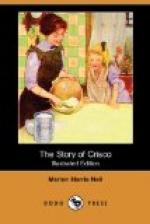To carve leg of mutton, stand joint the inner part of the leg uppermost and cut across center to bone, towards carver, then cut rather thick slices on either side. To serve the meat equally, unless any special part is desired, a portion of the knuckle is served with a slice of the thick end. The prime fat is the kernel of fat at the thick end.
To carve forequarter of mutton or lamb. The forequarter of mutton usually is not served whole unless the mutton be very small. The forequarter of lamb frequently is served whole. Before cooking it must be jointed through the chine of bone at the back, to enable this portion being served in chops, twice across the breastbones the entire length, and at short intervals at the edge of the breast. Before serving it is usual to separate the shoulder by pressing the fork in by the knuckle, then passing knife round shoulder, crossing about center of joint, raising shoulder without cutting too much meat off breast. Leave shoulder in position on joint; a second dish is sent to table on which to lay it while the other part is being carved.
To carve rabbit or hare. In either case first separate legs and shoulders; then cut the back part across, into two parts. This is accomplished best by inserting the knife into joint, and raising up the back by means of the fork. The back or fillet part is considered the best portion of a hare or rabbit.
To carve sirloin of beef, a sirloin should be cut into thin slices with a sharp, firm cut from end to end of the joint. At the upper portion the cut should be clean and even; then use point of knife to loosen slices from bones. In carving undercut, remove superfluous fat, and cut slices from end to end in same manner as upper portion. Be careful always to cut down straight to the bone of a sirloin or rib of beef; by so doing you will not spoil appearance of joint, and what remains will look tidy.
To carve ham. Ham should be cut through to the bone first from center or near thin end. Slices must be cut thin. Always commence cutting from upper side. The fairest way by far, so as to serve fat and lean evenly, is to begin cutting from center of thickest part, and to cut thin circular slices; by this means the flavor of the ham is far better, and it will prove to be the more economical way of serving.
To carve ox-tongue. Commence cutting from middle of tongue; cut slices not too thin and take them from each side being careful not to cut slices through to bottom part of tongue. Extreme end of the tip and the lower part of tongue generally are used up for chopping in salpicons, etc. A little of the fat should be put on each plate. When rolled tongue is served it must be cut horizontally into rather thin slices.
To carve fish. A silver sheer or trowel should be used for this purpose; a steel knife applied to fish often spoils the delicacy of its flavor. Great care must be taken to prevent breaking the flakes, which ought to be kept as entire as possible. Short-grained fish, such as salmon, etc., should be cut lengthwise, not crosswise.




